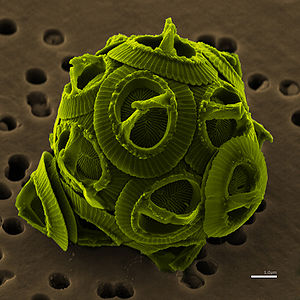
Hacrobia
Encyclopedia

SAR supergroup
The SAR supergroup is a clade that includes Stramenopiles , Alveolates, and Rhizaria.The first letter of each group provides the "SAR" in the name.It includes most of the organisms in the Chromalveolata grouping, but not Hacrobia....
.
The term "Hacrobia" has been proposed for this group. The "Ha-" refers to haptophyta, the "-cr-" refers to cryptomonads, and the "-bia" is a general suffix referring to life.
The term "Eukaryomonadae" has also been used for this group.
Members
It includes Haptophyta and Cryptophyta (including katablepharidKatablepharid
The katablepharids, a group of heterotrophic flagellates, have been considered as part of the Cryptophyta since katablepharids were described in 1939...
s).
In the past, heterokont
Heterokont
The heterokonts or stramenopiles are a major line of eukaryotes currently containing more than 100,000 known species. Most are algae, ranging from the giant multicellular kelp to the unicellular diatoms, which are a primary component of plankton...
s, haptophyte
Haptophyte
The haptophytes, classified either as the Prymnesiophyta or Haptophyta, are a division of algae.The term "Haptophyceae" is sometimes used. This ending implies classification at a lower level...
s, and cryptomonad
Cryptomonad
The cryptomonads are a group of algae, most of which have plastids. They are common in freshwater, and also occur in marine and brackish habitats. Each cell is around 10-50 μm in size and flattened in shape, with an anterior groove or pocket...
s have been sometimes grouped together in a group known as chromist. Though the heterokonts are now split out, Cryptophyta and Haptophyta are considered to be closely related (and are sometimes simply referred to as the "Cryptophyta+Haptophyta" group.) A 2009 paper also suggests that the Telonemia
Telonemia
Telonemia is a phylum of microscopic eukaryote, single-celled organisms. They are protists and are suggested to have evolutionary significance in being a possible transitional form between ecologically important heterotrophic and photosynthetic species among chromalveolates.One paper places them in...
and centrohelid
Centrohelid
The centrohelids or centroheliozoa are a large group of heliozoan protists. They include both mobile and sessile forms, found in freshwater and marine environments, especially at some depth.-Characteristics:...
s may form a clade with the cryptophytes and haptophytes. The picobiliphyte
Picobiliphyte
Picobiliphytes or Picobiliphyta are a group of eukaryotic algae, discovered in 2007, which are found among the smallest members of photosynthetic picoplankton.They are sometimes called "biliphytes".-Discovery:...
s may belong in this group but are too poorly known to be classified with confidence.

